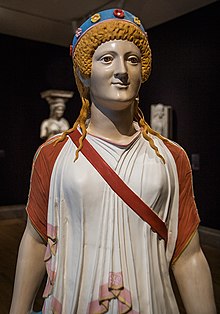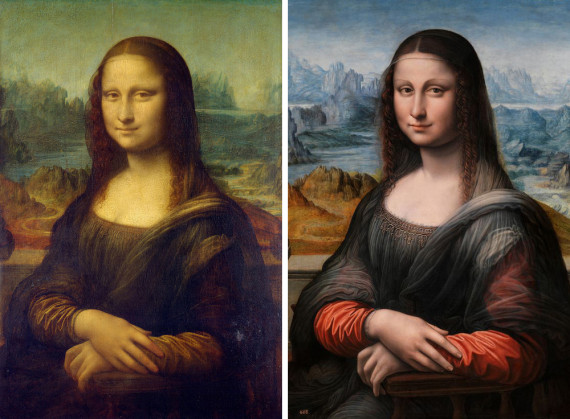Artists
Related: About this forum'Gods In Color- Golden Edition': New Light On Ancient Classical Statues, Frankfurt Exhibit
Last edited Mon Feb 3, 2020, 08:06 PM - Edit history (2)
'Gods in Color': Shining new light on ancient statues. DW/Deutsche Welle, Feb. 3, 2020. Excerpts: (~ Here's to color!).
The knowledge that ancient Greek and Roman statues were colorfully painted has largely been suppressed in recent centuries. An exhibition explores this shaded past and shows figures in their vibrant original hues.
We often think of ancient statues as the white stone figures that have long dominated museum collections. But in recent years, the public has been reawakened to the fact that many of these antiquities were once brightly colored. In the exhibition "Gods in Color - Golden Edition," which features over 100 painted sculptures in Frankfurt's Liebieghaus museum, visitors can witness the polychromatic transformation of ancient statues and experience their original, eye-opening bright hues.

- The myth of colorlessness: "This strange concept of colorless sculptures dates back to the Renaissance," said archaeologist Vinzenz Brinkmann, head of the Antiquities and Asia departments at the museum and the curator of the show. Since beginning his research in Athens 40 years ago, Brinkmann has been studying the colors of ancient sculptures and brings his specialist expertise to the exhibition. "At that time in Rome, there was a lot of construction happening and one sculpture after another was found. They no longer had any color."
So at first, no one knew any better, he explained to DW. At the same time, the simplicity of colorlessness fit with the popular ideology of the period. "The colorless sculptures were used as a visual representations of the Enlightenment," Brinkmann added. The lack of color made the figures lose their sensuality, said the archaeologist. "They were put, so to speak, on a pedestal." Even the finding of the Laocoön and His Sons statue in Rome in 1503, which showed traces of color, could not shift assumptions about ancient statues being white. "It was deliberately looked over," Brinkmann said.
But as the exhibition shows, colors were used diffusely in the ancient world, with the Greeks and Romans painting their sculptures, not only for decoration, but to elaborate the story of each work. Polychromy gave increased depth of cultural and artistic expression. - New findings — and a fascist backlash..But with the rise of fascism in the 20th century, the tide turned again. The colorful figures of antiquity did not fit in with the aesthetics of dictators Mussolini, Franco, Hitler or Stalin. They were simply too sensual, says Brinkmann...
https://www.dw.com/en/gods-in-color-shining-new-light-on-ancient-statues/a-52240659
* EXHIBIT CATALOG, https://buntegoetter.liebieghaus.de/en/
- Archer from the western pediment of the Temple of Aphaia on Aigina, reconstruction, color variant A, as exhibited in Athens, perhaps depicting the Trojan prince, Paris.

- The Greek goddess Artemis, color reconstruction of a first century AD statue found in Pompeii, an imitation of Greek statues of the sixth century BC, reconstructed using analysis of trace of color.
- More, https://en.wikipedia.org/wiki/Gods_in_Color
- Peplos Kore, alternative reconstructions.

-> The exhibition "Gods in Color" at the Liebieghaus Museum in Frankfurt features over 100 works in their original colors.
lunatica
(53,410 posts)The ongoing search for the true depiction of old art is fascinating and surprising sometimes. An example is Michelangelo’s art in the Sistine Chapel. Over five centuries of existence it got dark with candle soot and age, so everyone thought he chose dark colors. Then when it was renovated and cleaned up it turned out he used pinks and baby blues and light yellows and that his painting were airy and full of light. It’s great when these discoveries are made and honored.
appalachiablue
(43,348 posts)smoke especially, centuries ago. Collectors & specialists could have been afraid of damaging precious artworks as well.
Conservation has really advanced, nothing like a careful cleaning to bring a work back to life.
Alternative studies and compositions are sometimes discovered by x-ray tech in advance of cleaning also.
Serious cleaning.
Bayard
(24,168 posts)Thanks for posting!
appalachiablue
(43,348 posts)artworks. The 'Night Watch' turned to 'Day Watch'! and what different color view of the Mona Lisa. ~ I need more time on this article, I just found it.
- 7 Famous Artworks That Are Supposed to Look Completely Different, Huff Post, 2017
https://www.huffpost.com/entry/famous-artworks-different_n_6101952
The ceiling of the Sistine Chapel at the Vatican was restored just before the turn of the millennium, which took Michelangelo’s cracked, darkened work and returned some semblance of the original intent. One scene depicted by Michelangelo is the casting out of Adam and Eve from the Garden of Eden.
Their taking of the fruit allows them to see the truth while separating them from their maker, much like art restoration opens our eyes to what a painting is supposed to be while taking away the original strokes of the creator. Since the Sistine Chapel ceiling has been restored, the light surrounding Adam and Eve has shined much more brightly — illuminating more clearly than in decades both the beauty and the loss.
Art restoration is a tricky game. Perhaps worthy to note is a quote often attributed to Leonardo da Vinci: “Art is never finished, only abandoned.” Whether the original version of a piece or the deteriorated, surviving piece is the “true” artwork is all opinion.
Though, many of our civilization’s “masterpieces” don’t appear as they were originally supposed to look...

The Mona Lisa painting and the Mona Lisa as it's *'supposed to be' according to the writer.
2. The “Mona Lisa” is supposed to be far from brown and yellow and much of the ambiguity is just from deterioration.
Bayard
(24,168 posts)As a long ago art major, I would love to see the exhibition.
appalachiablue
(43,348 posts)cities worldwide since about 2003. Guess I missed it, unless there's a way to get to Frankfurt! Lol.
Art lover here as well, many pleasurable years studying and following.
*What areas of art do you like?
https://en.wikipedia.org/wiki/Gods_in_Color
- MUCH MORE ON THE EXHIBIT!! https://buntegoetter.liebieghaus.de/en/
BigmanPigman
(52,528 posts)I feel the same about black and white and color photography.
It's cool and interesting to see the original colors, decorations, fashions, etc as they really were for historical records. I also enjoy the colorless beauty of the forms. The eye is forced to focus on the statue itself.
appalachiablue
(43,348 posts)each one has positives.

